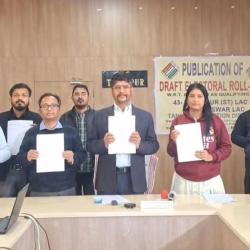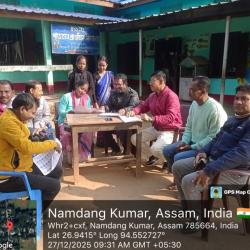Recently Guwahati has been listed as a priority city to be developed into a smart city. It is indeed a welcome shift for a B grade city like Guwahati. I have lived in this city since 1990s. The constant transformation which the city has gone through is indeed vey drastic. Urbanisation is a novel concept in India which reinvents itself in diverse forms whether through its infrastructure, its people, its institutions or through its disasters. Guwahati has tasted all these flavours to rest at its present condition. Guwahati is a unique city in India which has the perfect blend of hills, rivers, ponds and lakes and forests within its natural ecosystem within the rising sketch of its urban architecture.
We have seen how architecture of Guwahati city has shifted from tinned roof Assam-typed small houses to high raised flats in the residential spaces within Guwahati. Earlier only the rich and elite people could afford to build bungalows and two-storied houses with lawn, garage and out-houses within Guwahati. Flats were never considered as an option for affluent middle class job-holders within the Government and Private sectors. People planned their retirement stay by building medium to small independent homes which were aesthetically upgraded with innovative architecture and airy interiors. Use of bricks, traditional reed called ikora, clay, wood, cane and bamboo along with tin or asbestos to withstand rains, earthquakes and floods in Assam were mandatory. These ingredients also matched with the natural environment of Assam which was full of thick forests and layers of clay soil. But with time the natural ecosystem eroded to sandy mass without any trees and hence the architecture also shifted. It was no longer affordable and durable to construct traditional Assam-type houses. Only a few rich families could afford to maintain their traditional homes as it is with great difficulty. So the urban landscape went through a huge transition in terms of construction of multi-storied flats which is slowing becoming an unconditional norm. Builders would take the land ownership rights; transform the old property into new blocks of concrete with free custody of restricted spaces depending on the land holding size for the land owners. Many families within Guwahati fought with their siblings, parents and spouses to transform their independent houses into sleek and trendy flats to be shared with diverse people in lieu of exorbitant property rates which turned out to be a lucrative business proposition. Thus the urbanisation pattern of Guwahati on one hand equalised social class with the concept of residential flats irrespective of power, positions and resources but also disrobed people of their rights over their ancestral or acquired land. Concepts of home gardens, kitchen gardens and water resources within the households became archaic. In these shifts real estate became a very crucial business for the local residents and also other non-local residents who have lived and owned this city as their own through their skills, toil and trade.
Urbanisation does not necessarily ensure urban mindsets. People have raised flats, saved enormous bank balance and held huge property but they have never learnt to live progressive lives. The struggle for space in Guwahati is extremely disgusting for working professionals, students and women who would like to live independently. Hostels have been some of the most degrading spaces where women are exploited consistently and somehow women find themselves confined inside suffocating rooms crammed with complete strangers. When single women try to live on their own in independent residential spaces, they are subjected to discrimination which is unprecedented with peeping neighbours, voyeurism, unrealistic entry and exit conditions, restriction of visitors if they are from the opposite sex and sub-standard meals. Working women, women students and independent women who needed a space for themselves in this city have constantly been discriminated on all the above mentioned grounds. Sometimes even the caste, colour, race, religion, ethnicity and age of the women are also grounds for severe discrimination. I have come across people who were denied tenancy because they were non-vegetarians or they belonged to a different linguistic background. Some households in elite localities of Guwahati mention that they do not give rent to girls who are from ethnic communities, foreign countries, pork and beef eating communities, single, not working in state, banking and corporate agencies. Some localities are averse to women having many friends, attending or hosting parties, smoking in public and even inside their homes and going to bars, hotels and pubs for socialisation. Culture custodians of Guwahati city are constantly controlling women’s choices and mobility in the urban context of this smart city.
Urbanisation in Guwahati is lopsided as the city dismantles with every monsoon in more recent years. Incidents of manhole deaths, flash floods, drain blockades and health epidemics hits the news headlines when such incidents becomes as election agenda or party interests are hurt from either opposition or ruling parties. In most cases aftermath interventions of structural conditions of urbanisation are never resolved. In my experience of the urbanisation in Guwahati I have lived through more than 10 bomb blasts in the city in the past 12 years and millions of strikes and bandhs which used to collapse the city often. The city witnessed violent and inhuman treatment to protesters and public demonstrationists by state agencies in the heart of this ever transforming city of Guwahati. Both natural and human disasters have shaken the city in a number of occasions. Public spaces which adorn the city landscape in today’s Guwahati have been created with the hard toil of migrants, marginal workers, labourers from across Indian states of Bihar, Jharkhand, Bengal, Odisha, UP and also from neighbouring Bangladesh. But there seems to be a complete divide when it comes to claiming indigenous rights to an urban space. Urban spaces are always multi-ethnic, multi-cultural and cosmopolitan. The urban spaces need blended flavours of diversity not hegemonic monocultures.
The trends of urban sanitation have reached insurmountable heights after policy shifts and sudden realisation of business in human waste. The urban planning has recreated nooks and corners of the city to fit into public toilets. Some glaring examples are near hospitals, railway stations and under the flyovers. But all these spaces are paid so for the commoners on the street, such services are still unaffordable and inaccessible. The focus on declaring open defecation free zones is so high in villages but in cities such claims are unheard. Is it because of an assumption that in cities, open defecation, urinal and open bathing does not exist? If the answer is an affirmation then we are highly mistaken. In cities, such practices are equally common. Especially in Guwahati, market spaces, open grounds, parks and river banks do not have public toilets which could be used by vendors, street dwellers and commuters on foot and cycles. While surveying small shops, in different localities of Guwahati city, I have come across striking facts. Women workers, sales persons, labourers and vendors do not use any toilet space during their work hours. Even women officials in the state government offices find it very difficult to use the official or public toilets in their office premises. The main reason being low maintenance and non-availability of water in such toilets. Infact the Guwahati Press Club premises did not have separate toilets for women. Most of the public spaces and official establishments have urinals in their office premises. Street food vendors, small hotels and chai shops also do not have any access to sanitation in the urbanisation pattern of Guwahati. Not every person in Guwahati city can afford to step into expensive food joints with toilet and hand wash facilities.
Somehow urbanisation in Guwahati still has a long way to go. People have lived, died, loved and hated in this city but the city continues to live through their memories of triumphs and trials. In a mad rush to make Guwahati a smart city, hope that the people, policies and perspectives do not forget the individual and public memories which contributed to the making of this city a reality today.
(Samhita Barooah is a Researcher based in Guwahati)
- 8257 reads










Add new comment